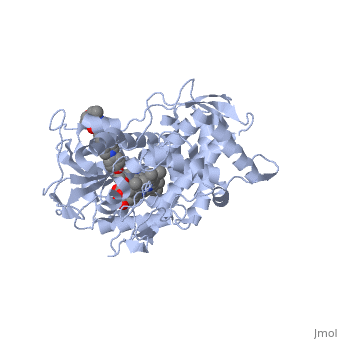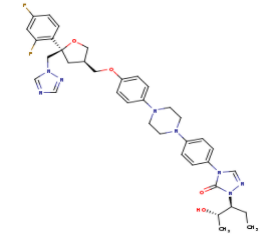Sandbox 123456
From Proteopedia
(Difference between revisions)
| (6 intermediate revisions not shown.) | |||
| Line 2: | Line 2: | ||
==Introduction== | ==Introduction== | ||
| - | Noxafil, also known as posaconazole, was developed by Schering-Plough in the mid-2000s <ref name="acs">Posaconazole. (2011, December 12). Retrieved from https://www.acs.org/content/acs/en/molecule-of-the-week/archive/p/molecule-of-the-week-posaconazole.html?_ga=1.240614083.1136742914.1490798730 </ref>, and is a broad spectrum antifungal drug mainly used to treat fungal infections caused by ''Candida'' and ''Aspergillus'' species and derived from a similar triazole antifungal agent, Itraconazole. It is especially effective against filamentous fungi. Noxafil is also often used when other antifungal medicines are not able to be tolerated or if the patient is immunocompromised. Noxafil falls under the triazole class of antifungal drugs and thus works through inhibiting the biosynthesis of ergosterol in the fungal cell membrane, an essential factor that if inhibited, will lead to prevention of cell growth and ultimately death <ref name=pubchem>National Center for Biotechnology Information. PubChem Compound Database; CID=468595, https://pubchem.ncbi.nlm.nih.gov/compound/468595</ref>. | + | Noxafil, also known as posaconazole, was developed by Schering-Plough in the mid-2000s <ref name="acs">Posaconazole. (2011, December 12). Retrieved from https://www.acs.org/content/acs/en/molecule-of-the-week/archive/p/molecule-of-the-week-posaconazole.html?_ga=1.240614083.1136742914.1490798730 </ref>, and is a broad spectrum antifungal drug mainly used to treat fungal infections caused by ''Candida'' and ''Aspergillus'' species and derived from a similar triazole antifungal agent, Itraconazole. It is especially effective against filamentous fungi. Noxafil is also often used when other antifungal medicines are not able to be tolerated or if the patient is immunocompromised. Noxafil falls under the triazole class of antifungal drugs and thus works through inhibiting the biosynthesis of ergosterol in the fungal cell membrane, an essential factor that if inhibited, will lead to prevention of cell growth and ultimately death <ref name=pubchem>National Center for Biotechnology Information. PubChem Compound Database; CID=468595, https://pubchem.ncbi.nlm.nih.gov/compound/468595</ref>. It was seen that in a group of patients undergoing chemotherapy or stem cell transplantation, posaconazole was the most effective at the prevention and elimination of invasive fungal infections when compared to alternative treatment options <ref> DOI: 10.1056/NEJMoa061094 </ref>. |
==Function/Structure== | ==Function/Structure== | ||
| Line 14: | Line 14: | ||
==Mechanism== | ==Mechanism== | ||
| - | When administered, posaconazole acts as a potent and broad-spectrum antifungal drug by binding to the <scene name='75/756730/Hemegroup2/1'>heme cofactor</scene> through an ionic bond between a neutral nitrogen atom on <scene name='75/756730/Posaconazole/1'>posaconazole</scene> and an iron atom on heme located in the active site of <scene name='75/756730/Cyp51/1'>CYP51</scene> . This prevents biosynthesis of ergosterol and causes accumulation of toxic methylated sterol precursor, 14-alpha-methylsterol <ref name="groll"/>. Ergosterol is an essential performs in fungal cells how cholesterol does in animal cells, making the cell membrane less permeable. Without it, the cells can no longer proliferate and eventually die because the cell membranes become “leaky”, releasing essential organic components from the cell’s interior and preventing it from performing normal cellular functions (citation?). In this way, posaconazole acts as a fungistatic against | + | When administered, posaconazole acts as a potent and broad-spectrum antifungal drug by binding to the <scene name='75/756730/Hemegroup2/1'>heme cofactor</scene> through an ionic bond between a neutral nitrogen atom on <scene name='75/756730/Posaconazole/1'>posaconazole</scene> and an iron atom on heme located in the active site of <scene name='75/756730/Cyp51/1'>CYP51</scene> . This prevents biosynthesis of ergosterol and causes accumulation of toxic methylated sterol precursor, 14-alpha-methylsterol <ref name="groll"/>. Ergosterol is an essential performs in fungal cells how cholesterol does in animal cells, making the cell membrane less permeable. Without it, the cells can no longer proliferate and eventually die because the cell membranes become “leaky”, releasing essential organic components from the cell’s interior and preventing it from performing normal cellular functions (citation?). In this way, posaconazole acts as a fungistatic against ''Candida'' species, and a fungicidal against ''Aspergillus'' species <ref name="formularyjournal" />. |
== Pharmaceutical Information == | == Pharmaceutical Information == | ||
| - | Noxafil is available in several forms, such as an oral suspension, gastro resistant tablets, and a concentrate (EMA). The pharmacokinetics and pharmacodynamics of Noxafil, specifically posaconazole, have been studied extensively and continue to be studied today to further improve the overall effectivenes of the drug | + | Noxafil is available in several forms, such as an oral suspension, gastro resistant tablets, and a concentrate (EMA). The pharmacokinetics and pharmacodynamics of Noxafil, specifically posaconazole, have been studied extensively and continue to be studied today to further improve the overall effectivenes of the drug <ref name="dekkers"/>. |
| - | Some of the most commonly reported side effects include nausea, diarrhea, | + | Some of the most commonly reported side effects include nausea, diarrhea, headaches, fever, vomiting, tiredness, and dizziness. |
Posaconazole has not been found to be have significant dose-limiting toxicity and has more reduced drug-drug interactions than many other antifungals (formularyjournal) | Posaconazole has not been found to be have significant dose-limiting toxicity and has more reduced drug-drug interactions than many other antifungals (formularyjournal) | ||
| + | It should be taken with food to help absorption and is generally taken 3 times a day in 200 mg doses. For fungi that have been unmanageable through other treatments, 800 mg are given daily 2 or 4 times a day to treat infection <ref name="greer"> Greer ND. Posaconazole (Noxafil): a new triazole antifungal agent. Proceedings (Baylor University Medical Center). 2007;20(2):188-196. PMID: PMC1849883 </ref> | ||
== Relevance == | == Relevance == | ||
| - | Invasive fungal infections, commonly caused by ''Candida'' or ''Aspergillus'' species affect patients that are immunocompromised such as those with different pre-existing infections or more seriously for those with immunologically suppressing diseases like HIV/AIDS. ''Candida'' (thrush/Candidiasis) is the most common yeast pathogen that typically grows in human mucosal surfaces like the intestinal tract and causes pathology when it becomes overgrown. | + | Invasive fungal infections, commonly caused by ''Candida'' or ''Aspergillus'' species affect patients that are immunocompromised such as those with different pre-existing infections or more seriously for those with immunologically suppressing diseases like HIV/AIDS. ''Candida'' (thrush/Candidiasis) is the most common yeast pathogen that typically grows in human mucosal surfaces like the intestinal tract and causes pathology when it becomes overgrown. ''Aspergillus'' is the most common mold pathogen leading to invasive fungal infections, termed Aspergillosis, when it is acquired from the surrounding environment <ref name="soysal">doi: 10.2147/IDR.S65592</ref>. Noxafil oral suspension is the best form of treatment for invasive ''Candida'' and ''Aspergillus'' infections in patients 13 years and older who are severely immunocompromised. Noxafil is also more effective at preventing invasive fungal infections in immunocompromised patients when compared to other antifungal treatments (fluconazole and itraconazole)<ref name="dekkers">doi: 10.1007/s12281-016-0255-4</ref> . Overall, Noxafil displays fewer cases of invasive fungal infections and is also a more affordable treatment for immunocompromised patients. There has been a noticeable increase in the incidence of invasive fungal infections particularly within patients receiving chemotherapy and transplant recipients. These patients are extremely susceptible because of their compromised immune system and the pressures from antibiotic usage, which is why invasive fungal infections are on the rise with these medical advances <ref name= "dekkers"/>. |
== References == | == References == | ||
<references/> | <references/> | ||
Current revision
| |||||||||||


